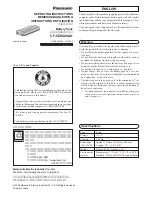
Battery charger NG1
D01273-00
6
Auxiliary
Contacts
Technical Features: changeovers contacts
0,3A 125VAC
0,3A 110VDC
1A 30VDC
Connector:
faston 6,3
×
0,8 mm
Unless otherwise stated, the auxiliary contacts provide the following functions:
Section Function
Description
AUX1
Mains Presence
When the equipment is switched on, the contact
Normally Open (NO) CLOSES and instead the contact
Normally Closed (NC) OPENS.
AUX2
End of charge or
Trickle Phase
When the Stop Phase or the No Stop Phase is reached,
the contact Normally Open (NO) CLOSES and instead
the contact Normally Closed (NC) OPENS.
Battery
A battery is characterised by two sizes: tension and capacity.
Tension:
Each element has a nominal tension, which depends on the type of battery (no
matter what size).
In order to reach higher tension, many elements are connected in series, so
creating a “BATTERY” of elements.
The number of elements is calculated by dividing the nominal tension of the
battery for the tension of each single element in the table:
Capacity:
It is the quantity of electric charge that the batteries can supply to an external circuit before the tension
decreases under the final limit value and it is obtained by multiplying the intensity of the discharging
current
I
, expressed in ampere (
A
), for the discharging time
t
expressed in hours (
h
):
C = I x t.
The traction battery capacity is normally referred to the discharging system of 5h:
C5 = I x 5h.
The capacity values that can be recharged by the battery chargers can be found in the description of the
Charging Curve (this value is not present in the curves able to charge any capacity).
:
This device is in conformity with the Low Voltage directive 73/23/EEC
and EMC directive 89/336/EEC and their further modifications.
NO
C
NC
NO
C
NC
AUX2
AUX1
Type
Nominal
Tension
Pb 2
V/cell
NiCd 1,2
V/cell
NiMH 1,2
V/cell
NiZn 1,714
V/cell






























